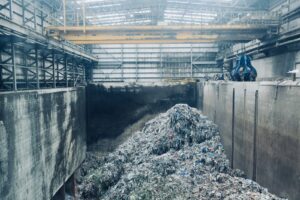Renewable energy on demand is key to net zero, but 24-7 clean electricity needs effective long duration storage. Now the world’s leading non-lithium-ion battery manufacturer is expanding, improving grid stability.
Larry Zulch is CEO of Invinity Energy Systems, and based at the US office in San Francisco, California. Created from the merger of Avalon and redT, companies that worked to commercialise vanadium flow batteries, the firm’s focus is making renewable energy a more reliable resource – available when needed, not just when it is produced.
In 2022, Invinity installed the largest flow battery in the UK, near Oxford, which is the largest hybrid vanadium/lithium energy storage system in the world, and the team are also responsible for the largest flow batteries in Canada, Australia, and, soon, the US. With a £50million investment now secured, half of which has come from the UK Infrastructure Bank, we find out more about the technology and plans for future growth.
What is a vanadium battery?
Like all batteries, a vanadium flow battery works by converting electricity into chemical energy to store it and then back into electricity to discharge it when needed.
Rather than lithium (or lead / other older kinds of batteries), in our batteries, the chemical energy is stored in a vanadium electrolyte, a water-based solution containing mild battery acid and vanadium. Vanadium is an element, number 23, more common in the Earth’s crust than copper. Pumps cause that liquid electrolyte to flow through a stack of membranes, hence the concept of a ‘flow’ battery.
What are the use cases for this technology?
The move to net zero has continued millennia-long trends and introduced entirely new factors. Invinity is fortunate to be at their intersection. The age-old trend is the quest for improved energy storage. Wood to coal and coal to oil are examples of moving to more compact, more usable energy storage.
Wood, coal, and petroleum products all store energy and produce it when needed. The new factor is that for the first time, energy production and energy storage are independent. A solar panel or a wind turbine produces energy but does not store it. To make solar or wind energy available when we need it, we must store it as a separate capability. That’s our business.
Our batteries are the size of shipping containers. They are large and bulky and cost a bit more than lithium batteries. They’ll never be in your car or pocket. But for stationary use at large scale, they’re very good. They don’t wear out or degrade, even when used for decades. They don’t catch fire and are at their best when they are operated continuously. Their uses include stabilising the electrical system by rapidly responding to variations in grid power and storing solar power for use when the sun isn’t shining, or wind power when the wind isn’t blowing.
When did vanadium flow batteries first enter the market?
Vanadium flow batteries were invented in Australia in the 1980s. Over the next twenty years they were proven to function well by a whole range of companies including the team who work at Invinity today.
Invinity’s innovation was to conceive of vanadium flow batteries as a standardised product that could be built in a factory rather than a custom engineering exercise. Invinity has proven that this factory-built-product approach is an effective way to reduce costs and increase reliability.
Now we are about to demonstrate that we can do the same thing at even larger scale. We have announced that we are co-developing our next-generation product with Siemens Gamesa Renewable Energy and their wholly owned subsidiary, Gamesa Electric. The resulting product, code-named Mistral, has already received significant support from governments and organisations in the UK, the US and elsewhere.
Mistral will take vanadium flow batteries to a new, higher level of application for grid-scale projects in our core markets of the US and UK, and around the world.
What will Invinity use the funds for?
First and foremost, we are focused on completing our next generation of product and bringing it to market. We are getting close: we are planning the first customer shipments this year, after an official announcement and disclosure of the actual product name.
We received support from the UK Infrastructure Bank and will be demonstrating the viability of longer-duration energy storage on the UK grid. To date, most energy storage in the UK has been appropriate for short-term grid stability but does not hold enough energy to make renewable energy truly available 24/7. Low-cost, low-carbon renewable energy on demand is key to a net zero transition.
We are also focused on rolling out our products across other markets such as North America, particularly the US where energy storage is strongly supported, but lithium batteries are not universally accepted. To address the large and growing demand for our products globally, we will need to significantly expand our manufacturing capacity across our core markets and partner up with key players further afield to meet the needs of our customers in the near future, so we will certainly utilise a portion of our funds to do this. Watch this space.
More quick questions:

















